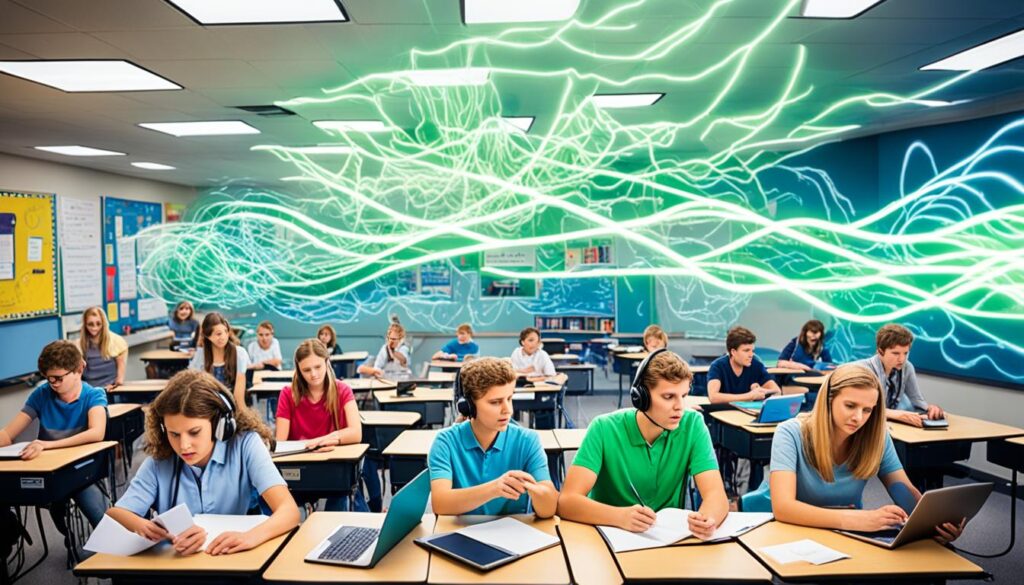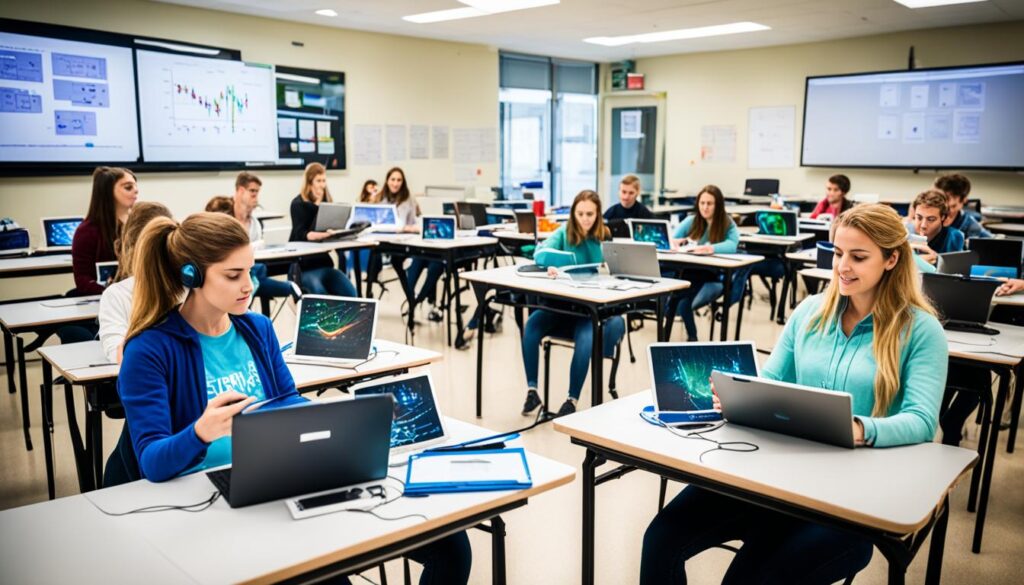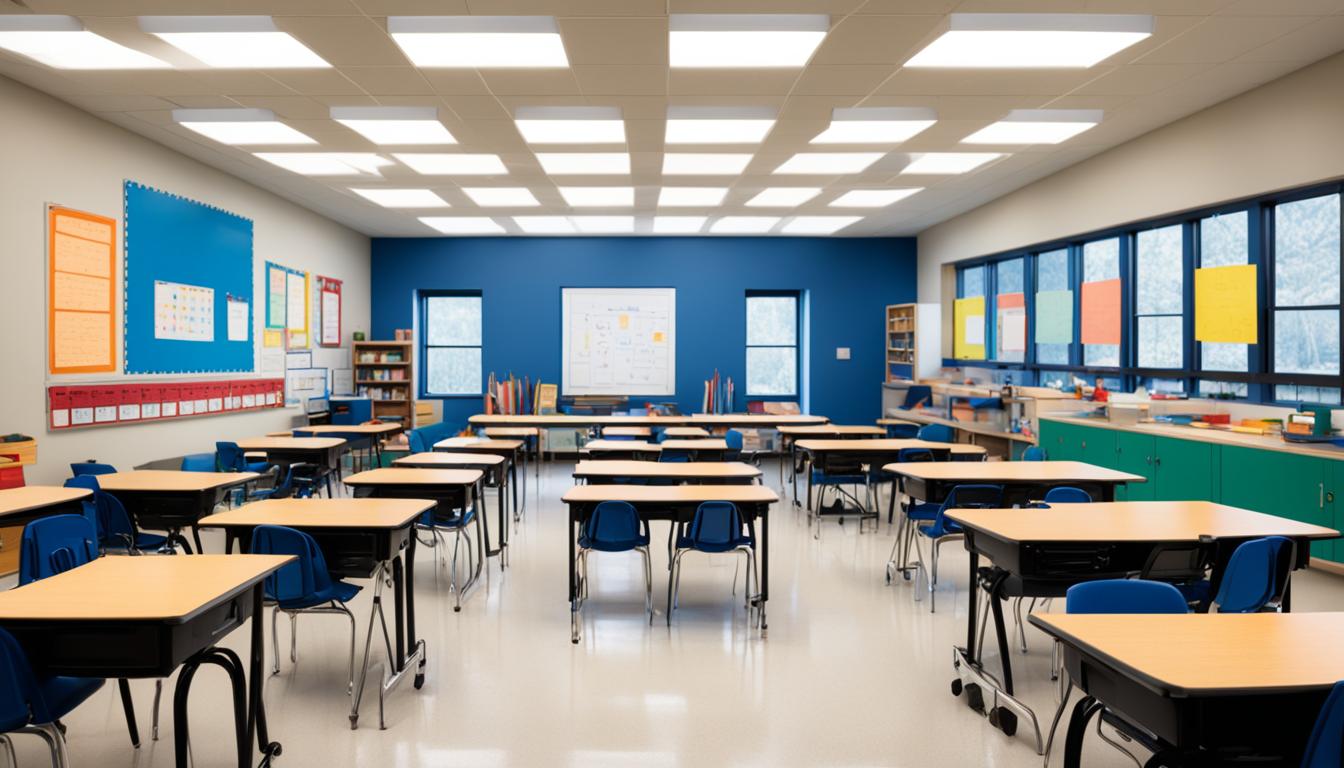Disclosure: This Post Contains Affiliate Links; We earn a commission on purchases.
As technology becomes an integral part of our daily lives, it’s crucial to address the potential health risks associated with electromagnetic field (EMF) radiation, especially in educational settings.
Children, who are more susceptible to the biological effects of EMF radiation due to their developing bodies, spend a significant amount of time in classrooms surrounded by electronic devices and wireless technologies. To ensure a safer and healthier environment for students, schools and teachers should prioritize EMF awareness and take proactive measures to minimize their exposure to EMFs.
Key Takeaways:
- EMF radiation is a concern in educational settings due to potential health risks, especially for children.
- Electronic devices and wireless technologies emit EMF radiation, which can have adverse effects on students’ health.
- Promoting EMF awareness among school staff and educating teachers about the risks is crucial.
- Implementing safety measures, such as encouraging the use of wired connections and reducing wireless networks, can help minimize EMF exposure.
- Parents play an important role in promoting EMF awareness and protecting their children from excessive exposure at home.
Understanding EMF Radiation in Schools
EMF radiation, also known as electromagnetic field radiation, is a concern in educational settings due to the potential health risks associated with long-term exposure. Schools are filled with various electronic devices and wireless technologies that emit electromagnetic fields, including cell phones, tablets, Wi-Fi routers, and smart meters. These devices contribute to the overall level of EMF radiation in classrooms.
Children, with their developing bodies and higher absorption rates, may be more vulnerable to the biological effects of EMF radiation. Prolonged exposure to EMFs can lead to various health issues, including potential neurological and immune system disorders. Therefore, it is crucial for schools to implement safety measures to reduce EMF exposure in classrooms and create a healthier learning environment for students.
In order to achieve EMF safety in schools, it is important to understand the sources of EMF radiation and take appropriate measures to minimize exposure. This includes:
- Limiting the use of personal electronic devices and promoting responsible EMF usage.
- Ensuring proper placement and distance of Wi-Fi routers to minimize EMF exposure.
- Encouraging the use of wired connections over wireless networks whenever possible.
- Providing education and awareness to teachers, students, and parents about the potential risks of EMF radiation and how to reduce exposure.
Creating an EMF-free learning environment is not only essential for the health and well-being of students but also for their ability to concentrate and learn effectively. By taking proactive steps to reduce EMF exposure in schools, we can create a safer and healthier environment for our students to thrive.
Importance of EMF Protection for Students
Protecting students from EMF exposure in schools is crucial to mitigate potential health risks associated with electromagnetic radiation. By promoting EMF awareness among school staff and educating teachers about the risks, we can empower them to implement necessary precautions and minimize students’ exposure to EMFs.
Creating an EMF-free learning environment not only prioritizes students’ overall health and well-being, but also enhances their ability to focus and learn effectively. By understanding the benefits of EMF awareness in schools, educators can take proactive steps to safeguard students from the potential dangers of electromagnetic radiation in educational institutions.
Educating teachers about EMF risks is vital as they play a significant role in students’ daily lives and can contribute to the implementation of effective protective measures. By equipping teachers with the knowledge and tools to identify and reduce EMF exposure, we can create safer learning environments for students.
EMF awareness among teachers is key to minimizing electromagnetic radiation in schools and ensuring the well-being of students. With the right education and precautions, we can foster an environment that not only supports academic achievement but also prioritizes the long-term health of our young learners.
<!–
| Benefits | Educating Teachers | Electromagnetic Radiation in Educational Institutions |
|---|---|---|
| Reduced health risks for students | Enhanced awareness and implementation of protective measures | Minimized exposure to EMFs in schools |
| Improved focus and learning outcomes | Empowered educators promoting EMF-free environments | Creation of healthier educational settings |
| Long-term well-being of students | Identification and reduction of EMF sources | Prioritization of student health |
–>

<!–
Benefits of EMF Awareness in Schools:
- Reduced health risks for students
- Improved focus and learning outcomes
- Long-term well-being of students
Educating Teachers on EMF Risks:
- Enhanced awareness and implementation of protective measures
- Empowered educators promoting EMF-free environments
- Identification and reduction of EMF sources
Electromagnetic Radiation in Educational Institutions:
- Minimized exposure to EMFs in schools
- Creation of healthier educational settings
- Prioritization of student health
–>
Types of EMF Exposure at School
In today’s technologically advanced world, children are exposed to various forms of EMF radiation while at school. These exposures come from multiple sources, including:
- Cell Phones and Wireless Devices: Many students carry cell phones and use wireless devices such as smartphones and tablets, which emit EMF radiation consistently throughout the day. This continuous exposure can have long-term health implications.
- Smart Meters: School buildings often have smart meters installed, which transmit data wirelessly. These devices emit high levels of EMF radiation and can contribute to an overall increase in exposure.
- Electric Fields in the Classrooms: Electrical wiring and electronics in classrooms can generate electric fields, which can add to the EMF exposure levels. Students spend a significant amount of time in these environments, making it important to consider these potential sources.
It is crucial for schools to be aware of these sources of EMF exposure and take proactive steps to minimize them. By promoting the use of wired connections over wireless networks and implementing measures to limit exposure to EMF radiation, schools can create a safer and healthier learning environment, free from excessive EMF radiation.
| Source of EMF Exposure | Potential Health Risks | Precautions to Minimize Exposure |
|---|---|---|
| Cell Phones and Wireless Devices | – Increased risk of brain tumors – Negative impact on fertility – Disrupted sleep patterns | – Encourage the use of wired headphones – Limit screen time and encourage breaks – Store devices away from the body – Educate students about safe phone and device usage |
| Smart Meters | – Potential neurological effects – Disruption of the body’s natural electromagnetic balance – Negative impact on sleep quality | – Position smart meters away from classrooms and areas with high occupancy – Consider alternative solutions to reduce wireless transmission |
| Electric Fields in the Classrooms | – Negative impact on concentration and cognitive function – Potential disruption of biological systems | – Optimize classroom wiring to minimize electric fields – Arrange furniture to reduce exposure – Educate teachers and staff about EMF awareness and reduction strategies |
Quote:
“By understanding the various sources of EMF exposure in schools and taking appropriate precautions, we can create a safer and healthier learning environment for our students.”

By acknowledging and addressing the different types of EMF exposure at school, educators and school staff can play a significant role in promoting EMF awareness among school staff and ensuring the protection of students. Creating an EMF-free learning environment is crucial for the overall well-being and educational outcomes of our children.
Strategies for Reducing EMF Exposure in Schools
Creating a safer learning environment for students involves implementing effective strategies to reduce EMF exposure. By taking proactive measures, schools can significantly minimize the potential health risks associated with electromagnetic field radiation. Here are some practical strategies to help protect students from excessive EMF exposure in classrooms:
Promoting Wired Connections
Encouraging the use of wired connections, such as Ethernet cables, can greatly reduce EMF radiation in the classroom. By utilizing wired networks instead of relying solely on wireless connections, schools can create a safer learning environment for students. Wired connections not only minimize EMF exposure but also offer more stable and reliable internet connectivity.
Encouraging Airplane Mode Usage
Promoting the use of airplane mode on personal devices, such as smartphones and tablets, can further minimize EMF exposure in classrooms. When not needed for educational purposes, students can be encouraged to switch their devices to airplane mode, which disables wireless connections. This simple step can significantly reduce EMF radiation emitted by personal devices.
Implementing EMF Protection Products
Schools can consider implementing EMF protection products to provide an additional layer of defense against electromagnetic radiation. For instance, EMF shielding patches can be applied to school uniforms to reduce exposure to EMFs. Additionally, installing EMF protection devices in classrooms, such as shielding curtains or wallpaper, can help create an environment with lower EMF levels.
Creating EMF-Free Zones
Designating specific areas within the school as EMF-free zones can provide students with a safe space to minimize EMF exposure during breaks. These zones can be established by implementing stricter rules regarding the use of personal devices or by designating specific areas as technology-free zones. Students can utilize these areas to recharge, relax, and reduce their overall exposure to electromagnetic radiation.
Providing Education and Awareness
It is crucial to educate students, teachers, and staff about the importance of reducing EMF exposure and the potential health risks associated with electromagnetic radiation. By providing comprehensive EMF awareness programs, schools can empower individuals to make informed decisions and take necessary precautions to minimize EMF exposure both inside and outside the classroom.
| Strategies | Benefits |
|---|---|
| Promoting Wired Connections |
|
| Encouraging Airplane Mode Usage |
|
| Implementing EMF Protection Products |
|
| Creating EMF-Free Zones |
|
| Providing Education and Awareness |
|
By implementing these strategies and fostering a culture of EMF awareness, schools can prioritize the well-being of their students and create a healthier learning environment with reduced EMF exposure.
Role of Parents in EMF Awareness
Parents play a crucial role in promoting EMF awareness and ensuring the well-being of their children in this digital era. It is important for parents to educate themselves about the potential health risks associated with EMF radiation and take necessary precautions to protect their children from excessive exposure.
One effective way for parents to promote EMF awareness is by encouraging the use of wired connections at home. Wired connections, such as ethernet cables, can significantly reduce the amount of EMF radiation emitted compared to wireless networks. By prioritizing wired connections for devices like laptops and gaming consoles, parents can limit their children’s exposure to harmful electromagnetic fields.
Another important aspect of EMF protection for students is setting limits on screen time. Excessive use of electronic devices not only contributes to increased EMF exposure but also has other adverse effects on children’s physical and mental health. It is essential for parents to establish screen time rules and encourage alternative activities that promote overall well-being, such as outdoor play and reading.
In addition to these preventive measures, parents can also consider providing their children with EMF protection products. EMF shielding devices or shungite necklaces are examples of products that can help minimize the potential harm caused by EMF radiation. These products are designed to reduce exposure by creating a barrier against electromagnetic fields.
By working together with schools and teachers, parents can create a supportive environment for EMF awareness and protection. Collaborating with educational institutions to implement EMF safety measures and educating other parents about the risks is crucial for safeguarding students’ health. By taking an active role in EMF awareness, parents can contribute to creating healthier learning environments for their children.
Comparison of EMF Protection Products
| Product | Description | Benefits |
|---|---|---|
| EMF Shielding Devices | These devices, such as EMF-blocking phone cases and laptop shields, are designed to reduce the amount of radiation emitted by electronic devices. |
|
| Shungite Necklaces | Shungite is a natural mineral that is believed to have protective properties against EMF radiation. Shungite necklaces are worn to minimize exposure to electromagnetic fields. |
|
Conclusion
Creating a safe and healthy learning environment is a top priority for educational institutions, and promoting EMF awareness is a crucial step towards achieving this goal. By understanding the potential risks associated with EMF radiation and implementing appropriate measures, schools and teachers can minimize students’ exposure to electromagnetic fields (EMFs).
Reducing EMF exposure in classrooms not only benefits students’ physical health but also enhances their ability to focus and learn effectively. An EMF-free learning environment allows students to thrive and reach their full potential without the potential biological effects of prolonged EMF exposure.
Collaboration between parents, schools, and other stakeholders is key in creating and maintaining an EMF-free learning environment. By working together, we can promote EMF awareness, educate parents about the risks, and implement necessary precautions to protect students from excessive EMF exposure.
In conclusion, prioritizing EMF awareness in educational settings is essential to ensure the well-being and success of our students. Let us strive to create EMF-free learning environments where students can flourish academically and thrive in a safe and healthy atmosphere.
Source Links
- https://www.orgoneenergy.org/blogs/news/back-to-school-safely-emf-protection-for-kids-in-school
- https://www.ncbi.nlm.nih.gov/pmc/articles/PMC7642138/
- https://ehtrust.org/educational-materials-for-classrooms/

Subscribe to Our Newsletter










